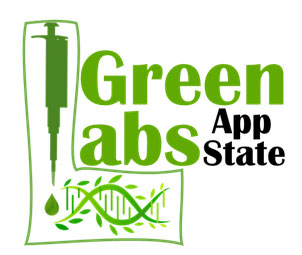GreenLabs
The App State GreenLabs Program is designed to educate and empower campus labs to work toward sustainability. Through management, training, and collaboration, labs work toward sustainable purchasing practices by sharing resources, energy and water conservation, and waste reduction efforts. The goal of this program is to reduce the carbon footprint of these areas of campus.

Energy Savings Campaign
The Green Labs Committee, in collaboration with the Lab Safety Committee, will be developing an energy savings campaign focusing on the following areas:
- Switch Off – turn off equipment whenever feasible; utilizing stickers to identify equipment that can be turned off at the end of the day, turned on as needed, or left on continuously.
- Shut the Sash – closing the sash on fume hoods when not in use.
- Chill Up – moving the storage temperature setting on ultra-low temperature freezers from -80C to -70C when possible.
Energy Management
Fume hoods, by design, consume a massive amount of energy. Conditioned air, whether it's cooled or heated, is continually exhausted, and the incoming supply air that is intended to replace the exhausted air must also be conditioned in order to maintain occupant comfort. When the university entered into an energy-saving performance contract in 2012, a demand-controlled ventilation system that senses air quality and occupancy around hoods was installed. This has been effective at reducing energy consumption of fume hoods, typically by 50%.
Even with these significant reductions, fume hoods still represent one of the most energy-intensive processes on campus. Recent efforts have focused on ensuring that the fume hoods are operating as they are intended. When fume hoods receive their annual recertification testing, App State staff and a third-party contractor recently adjusted more than 20 fume hoods so that the average face velocities were as close as possible to the school's standard of 100 feet per minute. With fume hoods running constantly, even minor adjustments can have a big impact
Battery Safety and Recycling
The Green Labs Committee has developed a Lithium Battery Safety Guide and continues to further develop battery and universal waste recycling programs campuswide.
Chemical Management
One of the most important ways to keep labs 'green' is maintaining an accurate inventory. This helps achieve sustainability initiatives by minimizing waste, reducing duplicate orders, and using resources more efficiently. App State has a contract with an inventory software called ChemInventory. This software can be used to track any kind of laboratory supply- not just chemicals. It is intuitive and natively contains a plethora of information relating to both safety and impact on the environment. Supplies marked as surplus are automatically enrolled in a facility's container recycling list so that users can help divert waste from landfills or other hazardous waste processing plants. Contact the safety office to get started with ChemInventory.
Future Project Ideas:
- Chemical storage and use
- Hazardous waste and chemical inventory efforts
- Management/training
- Purchasing
- Waste reduction and recycling